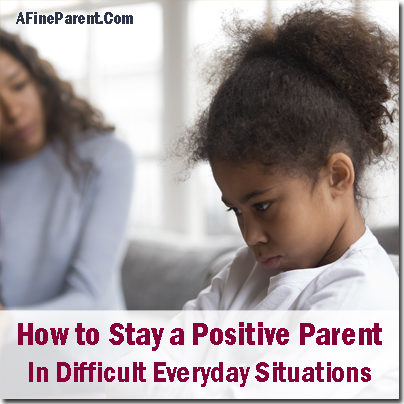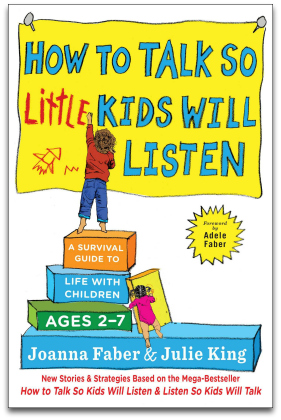 I try really hard to be a positive parent.
I try really hard to be a positive parent.
I’ve stopped yelling (mostly).
We practice special time.
I say something specific about their homework rather than simply “good job.”
Positive parenting has changed the relationship I have with my kids entirely. When it really matters, when I’ve had a stressful day or a task is really important to me, my kids listen. And when it really matters to them, I make them feel heard and valued.
But every so often, I find that regular everyday situations still trip me up. And just like that, I find myself struggling to stay on the positive parent wagon.
For example, today my youngest left his yogurt container on the table. Again. For the 400 billionth time. He left the lid, the spoon, and the goopy container, plus one banana peel for good measure.
And before I even realized what I was doing, I yelled, “Get over here and clean up after yourself! I am not the maid!”
In the process I ruined his morning. He stomped around, sulky and sullen. It was hard to get him to brush his teeth and put on his shoes.
It’s easy now that I’ve cooled off to know what I should have done. But in the moment, it was so hard to catch myself before I responded reactively.
I know I’m not alone in getting triggered by everyday challenging situations. Or even feeling confused sometimes about what a positive parent would do.
Below I have pulled three scenarios from the pages of the Positive Parenting Village Facebook Forum. The details have been obscured a bit to preserve anonymity, but each of these scenarios have been chosen because the issues present are universal. Everyone goes through these situations and has these feelings. We are not alone.
When we work through these situations offline, we are a lot less likely to trip up when Real Life presents us with similar situations. And a whole lot more confident in the Positive Parenting choices we make.
Please feel free to add in the comments section below what you would have done as a positive parent in these scenarios.
Scenario 1 – Tantrums
 I believe that my daughter’s tantrums are oftentimes purely manipulative. It’s often about putting something off (not wanting to brush teeth or clean up the toys) or wanting something that she can’t have. Once she gets what she wants (whether it be avoidance or gain) she’s learned that she’s won. My concern is that by using some of the positive parenting techniques instead of ignoring the tantrums and outbursts, my daughter will learn that her outbursts and tantrums work, and we’ll be training her to do exactly what we don’t want her to do, which is pitch a fit over anything and everything. I’m worried it’ll get WORSE. She doesn’t need coddling, she needs boundaries.
I believe that my daughter’s tantrums are oftentimes purely manipulative. It’s often about putting something off (not wanting to brush teeth or clean up the toys) or wanting something that she can’t have. Once she gets what she wants (whether it be avoidance or gain) she’s learned that she’s won. My concern is that by using some of the positive parenting techniques instead of ignoring the tantrums and outbursts, my daughter will learn that her outbursts and tantrums work, and we’ll be training her to do exactly what we don’t want her to do, which is pitch a fit over anything and everything. I’m worried it’ll get WORSE. She doesn’t need coddling, she needs boundaries.
Positive parenting through tantrums can be tough. Your child is having a Big Emotional Moment – often in public. It can feel like they are devious manipulators bending us to their will, but in reality they need our help.
Dr. Ross Greene says that children do well when they can and when they can’t it is because there is a lagging skill. “If he’s not capable of doing well, all the rewards and punishment won’t change that. The problem behavior might not improve or might even get worse.”
The first step is to let them have their emotions. Let them cry, scream, and carry on. Stay with them and remain calm. Don’t try to stop them or comfort them with bribes, threats, or giving in.
What is hard about helping your child manage a tantrum is that we often have no idea what caused it. A tantrum is a reaction to a situation, but what situation are they reacting to? Are they afraid, frustrated, tired, angry, or just hungry?
 After they are in a place where they can listen, we can help them tell us what it is they are feeling. Ask them, “are you sad you can’t have the toy?” or “are you mad that we are taking so long in the grocery store?” Asking questions like these teaches the child the language they will need to express themselves in the future.
After they are in a place where they can listen, we can help them tell us what it is they are feeling. Ask them, “are you sad you can’t have the toy?” or “are you mad that we are taking so long in the grocery store?” Asking questions like these teaches the child the language they will need to express themselves in the future.
Then we can bring in empathy and connection. “I wish I could buy you that toy, but today is not a toy-buying day.” When they protest again we can add, “I know you are disappointed. I am disappointed, too. But it just isn’t a toy-buying day today.”
By telling them “it isn’t a toy-buying day,” we are setting a gentle, but firm limit without setting the decision about whether or not we buy the toy on our own shoulders. It is the day’s fault. Not ours. We can be argued with, the day cannot. This makes it easier for the child to see us as empathetic and being on their side.
Also, I have discovered that sometimes the buying of the toy isn’t about having the toy at all. It’s about wanting to select things to put in the cart, just like we are doing. This is a great opportunity to give them a way they can do well. We can tell them, “What you can do is help pick up out the fruit for snack!” This gives our daughter a job to do and makes her our partner in the shopping experience.
Scenario 2 – Limits
 I have a 3-year-old girl. She doesn’t listen to me and no matter what I try it doesn’t work. She listens to my partner, but he uses fear and threats. I just can’t do that. I try to talk to her calmly, but that didn’t work. Then I tried other methods such as a firmer tone and bargaining, but that didn’t work either. My partner gets her attention immediately and she stops what she is doing, but only because she knows he will take her to her room if she doesn’t. So he threatens her with going to her room and she stops the behavior most of the time. I hate that he can get her to calm down and I can’t, but I just can’t use threats and a loud stern voice.
I have a 3-year-old girl. She doesn’t listen to me and no matter what I try it doesn’t work. She listens to my partner, but he uses fear and threats. I just can’t do that. I try to talk to her calmly, but that didn’t work. Then I tried other methods such as a firmer tone and bargaining, but that didn’t work either. My partner gets her attention immediately and she stops what she is doing, but only because she knows he will take her to her room if she doesn’t. So he threatens her with going to her room and she stops the behavior most of the time. I hate that he can get her to calm down and I can’t, but I just can’t use threats and a loud stern voice.
Your child is listening to the parent who, yes, is the loudest, but is also setting consistent limits for behavior. It is the consistent limit that is earning your daughters response, not the volume of the message.
The same result can be achieved through connection while being consistent with the limits you have set.
Let’s say she is playing ball in the house and you don’t like it when she kicks around a ball in the house. In fact, she could knock over plants or break a window! But she does it all the time. Here’s what you can say when want her to stop.
“You must really like kicking around that ball. I see you kicking it around all the time. We can take the ball outside and it will be much more fun and safer!”
If she is around four or five you can add some language about rules. “We have a rule: no playing ball in the house. It’s not safe. But you know what? Outside is the perfect place to kick balls around!”
Classically, the experts called this redirection. We are redirecting their energy towards kicking the ball outside. If it’s too dark out or it’s raining we can redirect them towards another activity that is appropriate for indoors. We can offer to play a board game or direct them towards a book about soccer or playing outside.
Taking this time to redirect them into playing something with you is a wonderful way to build connection. Having a strong and solid connection builds a communication highway between the two of you. You will find that the stronger your emotional bond, the easier it will be for her to hear what you are saying.
I found this with my own son. He’s fourteen now and because I redirected his energies into connection time, I don’t need to yell to get him to behave or respond to me. We even did cooking and cleaning together when it needed to be done as our together activities.
Were we always doing things together? No. Sometimes he went outside to kick his soccer ball around by himself. But because we had that connection he didn’t feel he was being punished for doing something wrong. Outside was simply the location for soccer.
Scenario 3 – Resisting Bedtime
 I have an 8 month old daughter. We always lay down with her to get her to sleep. I’d like to transition out of this habit because I am a full time student that relies on the nighttime hours to do homework.
I have an 8 month old daughter. We always lay down with her to get her to sleep. I’d like to transition out of this habit because I am a full time student that relies on the nighttime hours to do homework.
We had a solid routine that ended with a story and singing her to sleep. Now that I no longer lay with her and sing her to sleep she starts crying as soon as I mention bedtime. By the time I get her into bed she’s screaming bloody murder. She’s getting out of bed, hyperventilating, and yelling. I get SO angry because she will go on for hours. Tonight it took two hours of screaming to get her to bed. I feel like throwing in the towel. How can I gently transition her to getting into bed and settling on her own without me singing and cuddling her to sleep without all the screaming?
Bedtime is one of the most fraught moments of my parenting day. I still have chores to do as soon as they are in bed. They are suspicious that I am going to have the time of my life as soon as I am out of their sight. On top of it all, we are all tired. No wonder I lose my mind!
In this case, the family situation has changed and the bedtime routine must also change. Introducing a new routine will, by definition, take some time until it feels regular and consistent to the child. Until then it will feel scary and uncertain and your child will need extra understanding and connection.
Bedtime is often the only time in the day when a child feels truly connected to her parent. It’s just you and her. She gets stories and she gets songs that are meant just for her. When I changed my own kids’ bedtime routines it was a bumpy ride! But then I started adding 15 minutes of special time right after school where we could talk, read, or sing. Essentially, I added in an extra moment of telling them “I love you best in the world,” which helped to make our new bedtime routine feel not so disconnected.
 In this case, bedtime has become one big power struggle. Power struggles in parenting are not uncommon. As our children grow and mature they seek more autonomy for themselves. As a result that brings them into conflict with what we need them to do, like go to bed before we grow old and die.
In this case, bedtime has become one big power struggle. Power struggles in parenting are not uncommon. As our children grow and mature they seek more autonomy for themselves. As a result that brings them into conflict with what we need them to do, like go to bed before we grow old and die.
One of the best positive parenting solutions for power struggles is to give your child choices. Not about when their bedtime is or even the bedtime routine. I mean limited choices between two things that still have your child moving in the direction you need to go. This will fulfill their need for autonomy and independence while you side step the power struggle entirely.
In the case of bedtime we ask them, “Do you want to brush your teeth first or put on your pajamas?” Or if they are really distressed we can take a page out of the book How to Talk so Little Kids Will Listen, and make it a silly question like, “Do you want to wear your pajamas inside out or right side out?” The unexpected nature of the question breaks through the resistance in their heads. In a lot of cases, this kind of silliness can inspire our kids to participate willingly in the bedtime routine.
2-Minute Action Plan for Fine Parents
For a quick minute or two today think about where you struggle in your parenting. What moments of the day are the hardest for you? When are you most likely to yell or not be able to set limits? Are tantrums a trigger for you? How about defiance? Or bedtime?
Write down how you feel at these times. Write down what you say and how they respond. Then flip the script. Write down what your child might be feeling in these moments. What would they want you – as a loving, connected parent whose job it is to teach them how to be responsible – to say?
Long-Term Action Plan for Fine Parents
Now that you have written and thought about what’s the best you could say in these situations that drive you bonkers, give yourself a script. Write out exactly what you will say the next time they try to delay bedtime, or aren’t listening, or are having a tantrum. Feel free to keep the script with you in your wallet or pocket so that, in those moments, you will not be at a loss for words.
Try to build in moments of connection between the two of you. It can be short moments throughout the day or a big 15-minute block before or after school. The more time you can put into developing that communication highway, the easier it will be to parent through the tough moments.
Leave a Reply